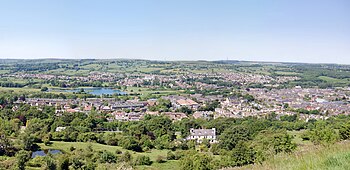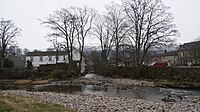Wharfedale

Wharfedale is one of the famous Yorkshire Dales; the dale formed by the River Wharfe coursing through the West Riding of Yorkshire.
Towns and villages in Wharfedale (in order, travelling downstream, from west to east) include Buckden, Kettlewell, Conistone, Grassington, Hebden, Ilkley, Burley-in-Wharfedale, Otley, Pool-in-Wharfedale, Arthington, Collingham, and Wetherby.
Beyond Wetherby the dale opens out, and becomes part of the Vale of York.
Upper Wharfedale
The section from the river's source to around Addingham is known as Upper Wharfedale and has a rather different character to the rest of the area. It is high in the Pennine hills. The first fifteen miles or so is known as Langstrothdale, including the settlements of Beckermonds, Yockenthwaite and Hubberholme, famous for its church, the resting place of the writer J B Priestley.
As it turns southwards, the Wharfe then runs through a green and lush valley, characterised by limestone outcrops, such as Kilnsey Crag, and woodland, generally quite unusual amongst the Dales.
Nature
Birds, beasts and fish
There are over 230 species of bird observed along the river valley including Eagle-Owl, Red Grouse, Stonechat, Whinchat, Golden Plover, Pied Flycatcher, Redstart, Wood Warbler, Common Sandpiper, Grey Wagtail, Dipper, Tawny Owl, Sparrowhawk, Greater Spotted Woodpecker, Nuthatch, Common Treecreeper|Treecreeper and, in wetter places, Snipe and Woodcock, Chiffchaff, Willow Warbler, Garden Warbler, and Twite.[1]
The Wharfe has populations of Signal Crayfish and the few White-clawed Crayfish remaining are at great risk.[1]
There are populations of Rabbit, Red Fox, Grey Squirrel, Otter, Water Voles and Deer.[1][2][3]
Plantlife
Ferns found here include Wall Rue, Maidenhair Spleenwort, Brittle Bladder-fern, Hart's-tongue and Hard Shield-fern. In Upper Wharfedale the scars and screes support a range of plants including the Alpine Cinquefoil and Hoary Whitlowgrass. Also to be found are Lesser Meadow-rue, Goldenrod, Scabious and Bloody Crane's-bill with, to a lesser extent, Mountain Melick, Limestone Fern, Wood Crane's-bill and Melancholy Thistle, Green Spleenwort, Wall Lettuce and Hairy Stonecrop.[1]
Lower down the valley, species including Alpine Cinquefoil, Lily-of-the-valley, Mountain Melick and Herb Paris, blue sesleria, Common Valerian and Wild Angelica. The limestone outcrops have uncommon species including Rock Whitebeam and Solomon's Seal as well as Bird's-eye Primrose, Butterwort, Rockrose, Dropwort and Limestone Bedstraw.
The limestone pavements of the area are a habitat for several species usually confined to woodlands, such as Dog's Mercury, Wood Anemone and Ramsons. Rarer species to be found in the grikes include Baneberry and Downy Currant. Ferns in the moist grikes include Rigid Buckler-fern. Also to be found are Alternate-leaved Golden Saxifrage, Reed Canary-grass and Stone Bramble.
Some of the inaccessible cliffs are home to ledge dwelling flora including mosses and liverworts, such as Red Leskea, Sharp Rock-bristle and the very rare ‘’Zygodon gracilis’’. The ledges also support Woodrush, Polypody and Water Avens, Purple Saxifrage, Yellow Saxifrage, Hoary Whitlowgrass and Roseroot.
Blue Moor-grass can also be found, with Sheep's-fescue and herbs such as Thyme, Salad Burnet and Common Rock-rose. There is Wild Thyme, Common Milkwort, Fairy Flax, Bird's-foot Trefoil, Autumn Gentian, Harebell, Eyebright.
Species of tree and shrub include Ash, Downy Birch, Hazel, Hawthorn, Yew and Rowan. In the woods shrubs such as Wild Privet and Spindle can be found. More rare is Dark Red Helleborine.[1][4]
Geology
Upper Wharfedale is an area from the Lower Carboniferous era and lies north-west of Burnsall. Its main features are the Great Scar Limestone which forms a base to the overlying Yoredale Beds, a set of strata 1,000 feet deep of hard limestones, sandstones and shale. These have been slightly tilted, toward the east. To the south-east of the area are the Millstone Grit laid down in the Upper Carboniferous era, and is covered by heather moorland, hard crags and tors.[5][6]
Weathering of the Yoredale Beds has produced a stepped profile to the valley sides, consisting of a shelf of limestone, sometimes grassy but often displaying such karst features as limestone pavement, gorges and sinkholes. During the last ice age, the local ice cap at the head of the Dales fed glaciers to produce the classic U-shaped profiles seen today.[7]
Where the river valley changes course into Lower Wharfedale, the change of underlying rock can be seen in the darker stone in the field walls. The Millstone Grit outcrops at the Cow and Calf Rocks near Ilkley form a rolling dissected plateau. Due to the impermeable nature of the rock, blanket bogs and mires form, and drier areas have wet and dry heaths and acid grasslands.[8]
Coarse sandstones in the area are known as Addingham Edge and Bramhope Grits. The Otley Shell Beds become exposed at Otley Chevin. At Great Dib Wood the Otley Shell Bed is sandwiched between two Namurian sandstones.
Glacial lakes once filled Lower Wharfedale and deposited sand and gravel. These were quarried and now form the basis of the Otley Wetland Reserve, and Ben Rhydding and Knotford Nook gravel pits.[9]
Historical interest
“Wharfe” is a river name from the British language meaning the “winding river”.[10][11]
Iron Age fields and hut circles can still be seen in outline on the hills above Grassington and Kettlewell.[6] The Romans built a road through Wharfedale that went over Stake Moss into neighboring Wensleydale. The Romans mined lead in the hills on Greenhow Hill overlooking Appletreewick until AD 410.[6] After AD 620 the ancestral English entered the dales to settle and farm, and they cleared forests to establish fields for crops and animals. The Danes and Norse, first as marauders then as farmers, came here, farming near Burnsall and Thorpe, and left an echo of their language to some of the names of hamlets and landscape features of Upper Wharfedale, especially near the head of the valley.[6] During Anglo-Saxon times, large estates were established and the River Wharfe and its valley came under the protection of Earl Edwin of Bolton-in-Craven. After the Norman invasion, the lands were given to Robert Romilly.[6]
In the Middle Ages low intensity methods were used to produce both crops and livestock but the great monasteries of Fountains Abbey, Rievaulx Abbey and Bolton Priory had large sheep flocks and sold their wool on the European market. In 1155, Alice de Romilly donated land for the establishment of Bolton Priory and land at Kilnsey to Fountains Abbey. The monasteries helped develop vast sheep farms and the founding of drove roads, which can still be seen and walked today. The success of the monasteries was also responsible for the growth of the market towns of Grassington and Kettlewell.[6]
When the monasteries were dissolved in 1539, and wool prices fell, many tenant farmers took to cattle and sheep rearing. However, at the end of the 17th century there was still small-scale arable production. By the early nineteenth century there was a demand for food from the growing industrial towns and farmers and many farms began to produce milk from the lower lands and use the higher fells for sheep.[12]
The dale on film
The dale has had appearances in films. In 1992, the town of Grassington was used as a filming location for Wuthering Heights.[13] The 2003 film, Calendar Girls, was filmed at several locations in the river valley including Buckden, Burnsall, Kettlewell and Kilnsey.[14]
Economy

A lack of investment in the Dales farms has led to problems related to more intensive farming methods. The loss of unproductive farms has led to land being merged with adjoining or nearby businesses, and an increase in second home ownership by people from outside the area. There are fewer people looking after the land with labour-intensive jobs such as sheepherding, rebuilding walls and barns, maintaining woodland no longer taking place. The increase in sheep-ranching has gone hand in hand with reduction in the number of cattle.[15][16]
Lead mining was once the main industry in Wharfedale. From the seventeenth century to the late nineteenth it employed hundreds of men and boys, exploiting the veins in the limestone at Greenhow, Hebden, Grassington, Linton and Conistone, Appletreewick and elsewhere. The heaps of mining waste remain, contaminated with lead, and on which little will grow. The few plants that will are known as 'lead plants' such as spring sandwort and alpine penny-cress.[17][18]
Tourism is big part of the rural economy in Wharfedale and there are many short, mid and long distance walks, with clear waymarkers. There are also other outdoor activities such as rock climbing, most notably at Kilnsey Crag, and canoeing. Other activities include cycling, mountain biking, horse riding and caving.[19] The following Long Distance Walks pass near or over the river:[20]
- Dales Way (follows the river valley from Beckermonds to Ilkley)
- Lady Anne's Way (enters the river valley near Hubberholme and leaves to the west of Bolton Abbey)
- Inn Way to the Yorkshire Dales (part of walk from Grassington to Buckden)
- The Way of the Roses (part of the cycle route from Appletreewick to Thorpe)
Outside links
References
- ↑ 1.0 1.1 1.2 1.3 1.4 "Habitats". Yorkshire Dales National Park Authority. 2013. http://www.yorkshiredales.org.uk/natureinthedales/habitats. Retrieved 25 March 2013.
- ↑ "Animals". http://www.wharfequest.co.uk/animals.htm. Retrieved 25 March 2013.
- ↑ "Animals". http://www.wharfequest.co.uk/birds.htm. Retrieved 25 March 2013.
- ↑ "Plants". http://www.wharfequest.co.uk/plantrees.htm. Retrieved 25 March 2013.
- ↑ "Langstrothdale Landscape Character Assessment". Yorkshire Dales National Park Authority. 2013. http://www.yorkshiredales.org.uk/nationalparkauthority/policiesandstrategies/nationalparkpolicies/landscapecharacterassessment/31_langstrothdale-2.pdf. Retrieved 25 March 2013.
- ↑ 6.0 6.1 6.2 6.3 6.4 6.5 "Upper Wharfedale & Littondale Landscape Character Assessment". Yorkshire Dales National Park Authority. 2013. http://www.yorkshiredales.org.uk/nationalparkauthority/policiesandstrategies/nationalparkpolicies/landscapecharacterassessment/32_upper_wharfedale_and_littondale-2.pdf. Retrieved 25 March 2013.
- ↑ "Craven Fault". Yorkshire Dales National Park Authority. 2013. http://www.yorkshiredales.org.uk/nationalparkauthority/policiesandstrategies/nationalparkpolicies/landscapecharacterassessment/33_wharfedale_craven_fault_area-2.pdf. Retrieved 25 March 2013.
- ↑ "Mid WharfedaleLandscape Character Assessment". Yorkshire Dales National Park Authority. 2013. http://www.yorkshiredales.org.uk/nationalparkauthority/policiesandstrategies/nationalparkpolicies/landscapecharacterassessment/34_mid_wharfedale-2.pdf. Retrieved 25 March 2013.
- ↑ "Geology". http://www.wharfequest.co.uk/geology_landscape.htm. Retrieved 25 March 2013.
- ↑ "Origin of name". http://www.outofoblivion.org.uk/upwharfedale.asp. Retrieved 2010-12-23.
- ↑ "Name of river". http://www.wharfequest.co.uk/local_history.htm. Retrieved 2010-12-25.
- ↑ "Area history". http://www.wharfequest.co.uk/. Retrieved 25 March 2013.
- ↑ "Filming Locations". http://www.imdb.com/title/tt0104181/locations/locations. Retrieved 26 August 2011.
- ↑ "Filming Locations". http://www.imdb.com/title/tt0337909/locations. Retrieved 26 August 2011.
- ↑ "Area economy". http://www.wharfequest.co.uk/. Retrieved 25 March 2013.
- ↑ "Culture and heritage". Yorkshire Dales National Park Authority. 2013. http://www.yorkshiredales.org.uk/specialplace/specialquality-culturalheritage. Retrieved 25 March 2013.
- ↑ "Lead mining". http://www.outofoblivion.org.uk/upwharfedale.asp. Retrieved 25 March 2013.
- ↑ "Mining". http://www.wharfequest.co.uk/industry.htm. Retrieved 25 March 2013.
- ↑ "Leisure activities". Yorkshire Dales National Park Authority. 2013. http://www.yorkshiredales.org.uk/index/outandabout/gettingactive.htm. Retrieved 25 March 2013.
- ↑ "Long Distance Walks". Yorkshire Dales National Park Authority. 2013. http://www.yorkshiredales.org.uk/index/outandabout/gettingactive/walking/longdistanceroutes.htm. Retrieved 25 March 2013.